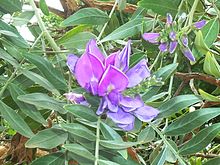
Cussonia is a genus of plants of the family Araliaceae, which is native to the Afrotropics. It originated in Africa and has its center of distribution in South Africa and the Mascarene Islands. Due to their striking habit, they are a conspicuous and easily recognizable group of plants. Their genus name commemorates the botanist Pierre Cusson. The Afro-Malagasy and Asian Schefflera, and Afrotropical Seemannaralia genera are related taxa that share several of its morphological characteristics, among which the leaves borne on the end of branches, inflorescences carried on terminal branches or stems, and reduced leaf complexity in developing inflorescences.

Leucosidea sericea, commonly known as oldwood, is an evergreen tree or large shrub that grows in the highland regions of southern Africa. It is the sole species in the monotypic genus Leucosidea. The name oldwood may reflect the fact that the wood burns slowly, as if old and rotting; the gnarled, twisted trunks reinforce this impression.

Protea angolensis is also known as the Angolan protea, northern protea or northern sugarbush. In Afrikaans it is known as the noordelijke suikerbos. This is a dwarf, multistemmed shrub or small straggling tree occurring in open wooded grassland and miombo.
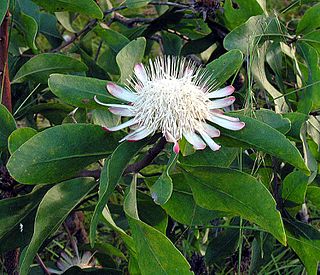
Protea gaguedi is a species of tree which belongs to the genus Protea.

Protea welwitschii is a species of shrub or small tree which belongs to the genus Protea, and which occurs in bushveld and different types of grassland.
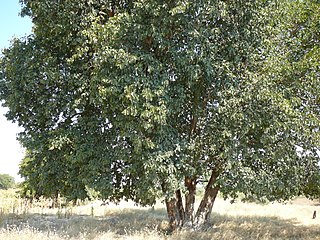
Baikiaea plurijuga, known as African teak, Mukusi, Rhodesian teak, Zambian teak or Zambesi redwood, is a species of Afrotropical tree from the legume family, the Fabaceae from southern Africa.

Aeschynomene elaphroxylon, also known as an ambatch, pith-tree, balsa wood tree, or umburu, is a common large shrub to small tree of the genus Aeschynomene in the family Fabaceae growing in swamps, lakes and rivers in Tropical Africa. It grows two to nine, exceptionally up to twelve, metres high, with a straight, thick, swollen, conical trunk. This is an unusual leguminous tree in that it grows in water as a freshwater mangrove, with an extremely lightweight wood acting as a float and a specialised root system sprouting from the trunk which forms a tangled web hanging through the water and sprawling through the mud. It has adventitious roots and roots which are differentiated into special structures adapted to the swamp environment. It can even grow as floating islands of drifting forests.

Capparis tomentosa, the woolly caper bush or African caper, is a plant in the Capparaceae family and is native to Africa.

Capparis fascicularis, the zigzag caper-bush, is a plant in the Capparaceae family and is native to Africa.

Croton gratissimus, is a tropical African shrub or small tree with corky bark, growing to 8 m and belonging to the family of Euphorbiaceae or spurges. Young twigs are slender and angular and covered in silver and rust-coloured scales.

Erianthemum dregei is a species of parasitic plant in the family Loranthaceae, and is commonly known as the hairy mistletoe or wood flower.

The broad-leaved coral tree is a deciduous tree from southern Africa growing 5 to 8 m tall. It is a member of the Fabaceae and occurs naturally in the Afrotemperate mist-belt of South Africa and Eswatini to the uplands of Mozambique, Zimbabwe and adjacent Botswana. It is often cultivated as a tree for gardens and parks. In Zimbabwe its range overlaps with the similar Erythrina abyssinica.
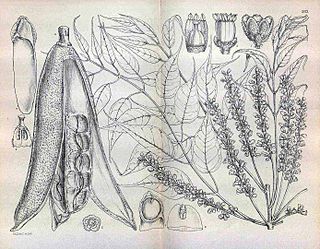
Entandrophragma caudatum, or mountain mahogany, is a large Southern African tree belonging to the mahogany family and found in eastern and north eastern South Africa, Eswatini, Botswana, Angola, the Caprivi Strip region of Namibia, Zimbabwe, Zambia and Malawi. Kew currently recognises 12 other species of Entandrophragma, all with a tropical and sub-tropical African distribution.

Hymenodictyon parvifolium Oliv. is a small rubiaceous African tree and is one of some 24 species in the genus, with a tropical African and Asian distribution. This species grows as a small tree to some 5 metres tall, or sometimes a liane or scrambler to 10.5 m, and is found in low-altitude woodland.

Cadaba aphylla ("Swartstorm") is one of the many species in the genus Cadaba. It is indigenous to southern Africa.
Balanites pedicellaris, the small green-thorn or small torchwood is a small tree or shrub from Sub-Saharan Africa. It is a member of the caltrop family Zygophyllaceae.

Drypetes arguta, commonly known as the water ironplum, is a species of small tree or large bush in the family Putranjivaceae. It is native to tropical East Africa. It was first described in 1920 by the English botanist John Hutchinson, who named it Cyclostemon argutus. It was later transferred to the genus Drypetes.
Vachellia kirkii, widely known as Acacia kirkii but now attributed to the genus Vachellia, is a tree native to tropical Africa. It is commonly known as the flood plain acacia.

Gardenia volkensii, commonly known as bushveldt gardenia or Transvaal gardenia, is a species of plant in the family Rubiaceae native to southern Africa.
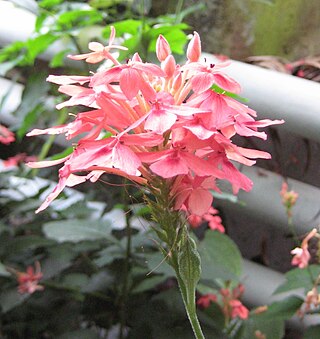
Ruspolia is a genus of flowering plants belonging to the family Acanthaceae.
